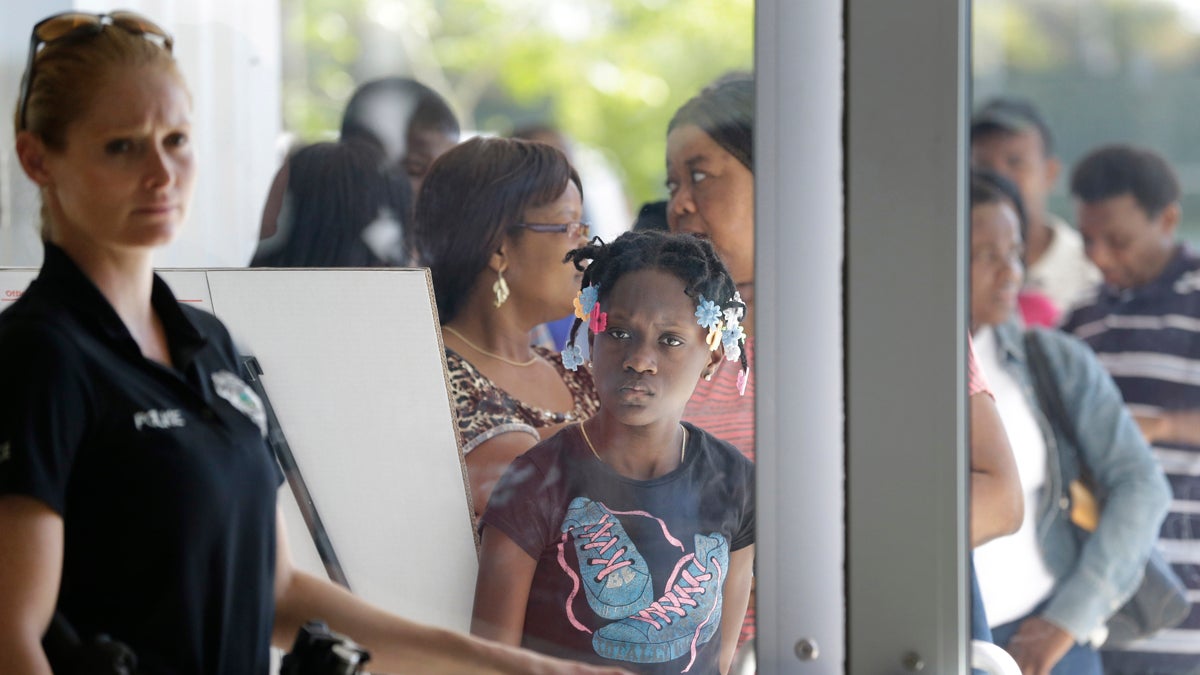Study questions affordability of health plans for some young adults under ACA
Listen
A police officer holds the door as people line up outside the Joe Celestin Center in North Miami, Fla., during the ACA’s National Youth Enrollment Day in February. (AP Photo/Wilfredo Lee)
As the March 31 Affordable Care Act enrollment deadline closes in, one group getting a lot of attention is made up of the “young invincibles,” those 18- to 34-year-olds, who tend to be healthier and less likely to have coverage through work.
The system is banking on enough of them participating, but a new study questions whether plans offered in major cities are affordable.
The ACA designed a subsidy system aimed at lowering insurance costs for individuals with incomes between about $11,000 and $46,000 a year, or 100 to 400 percent of the federal poverty level.
Kevin Coleman, with the health IT group Healthpocket, recently examined insurance plans in eight major cities, including Philadelphia. It turns out many young adults making less than $46,000 were still not eligible for those federal discounts on monthly premiums.
“What we found is that, on average, once you make about $31,744, you probably weren’t going to qualify for a subsidy,” said Coleman.
Coleman, who calls it a “subsidy gap” for young adults, said it’s due to a variety factors, including the current costs of health plans in a given city, an individual’s age, and how much a premium would represent as a percentage of that person’s income. The higher one’s income, the more expensive premiums must be before subsidies kick in.
That could translate to premiums ranging from $250 to $350 a month for some young adults, Coleman said.
“When you combine these results with the fact that young people under the age of 35 are statistically healthier, they probably place a lower priority on the need for health insurance,” he said. “This may help explain why we’re seeing an under-enrollment in the younger adults, versus the targets originally set by the administration.”
Some local advocates don’t buy this, including Bill England, Pennsylvania director of Enroll America, a nonprofit trying to maximize the number of people get ACA coverage. The group has dispatched hundreds of volunteers to staff phone banks, canvass neighborhoods and reach out to uninsured Philadelphians.
“They are excited to get the health coverage,” said England, adding that young adults account for more than a quarter of enrollees in Pennsylvania. “We talk in simple terms about the fact that having this health insurance does provide peace of mind for the unexpected. We see them taking action.”
England points to an earlier study that found that half of young adults nationwide are eligible for a basic plan that costs $50 a month or less. Even without assistance, he said, insurance plans are generally cheaper for that demographic because they’re young.
The region’s largest insurer, Independence Blue Cross, or IBX, also doesn’t seem too worried about young adult enrollments. IBX is one of of two companies offering ACA plans in Philadelphia. (Aetna is the other company.)
“Back in January, we had about 21 percent enrollment in the millennial population,” says Koleen Cavanaugh, director of consumer marketing for IBX. “We’re now around 31 percent, so we’ve seen a nice uptick in February enrollment numbers for that population.”
Cavanaugh said the majority of those young adults have been eligible for subsidies. Meanwhile, the company has reported more than 90,000 people in the region, across all ages, have enrolled in IBX plans since open enrollment started.
Coleman, with Healthpocket, said it won’t be until the deadline passes and the numbers have been crunched that he and others will know if this subsidy gap has been a problem.
This disclosure: Independence Blue Cross supports WHYY.
WHYY is your source for fact-based, in-depth journalism and information. As a nonprofit organization, we rely on financial support from readers like you. Please give today.

